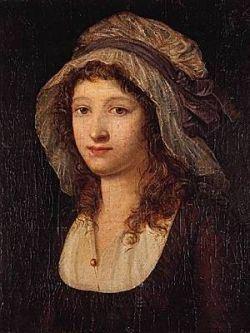
At 7am on the morning of Sunday, the 13th July 1793, a young woman, just twenty five years of age, with neatly arranged curling chestnut hair and clear blue eyes walked with a firm and steady tread through the already busy sun warmed streets of Paris from her lodging, room 7 in the Hôtel de la Providence, 19 Rue Hérold, to the arcades of the Palais Royal. We don’t know what thoughts ran through her head as she strolled purposely along, perhaps stirring lines written by her great great great grandfather, the celebrated playwright Pierre Corneille, or perhaps she stopped every now and again to enjoy the bustle and excitement that attended the preparations for the next day’s celebration of the fourth anniversary of the fall of the Bastille.
The elegant arcades of the former Royal palace were decorated for the occasion with tricolor banners, while the trees planted in the famous gardens were bedecked with tricolor ribbons that floated slightly in the morning breeze, while everywhere the woman looked she saw young people like herself laughing and smiling as they sang patriotic songs and looked forward to the festivities.
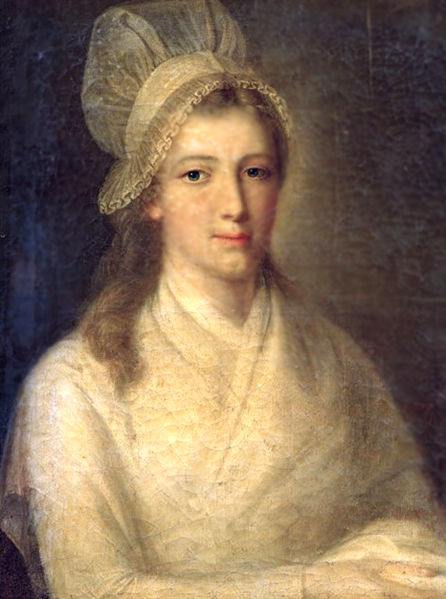
Marie-Anne-Charlotte de Corday d’Armont was not a Parisienne, despite the undoubted elegance of her brown striped silk dress, but was one of the last scions of a somewhat diminished aristocratic family from Caen in Normandy. The street vendor who sold her a newspaper before she entered into the cooling shelter provided by the colonnades, which were frequented at night by whores, gamblers, thieves and revellers drawn from all classes, would have noted that her accent was not that of a native Parisian but there was nothing unusual about that – since the outbreak of Revolution in 1789, the city had become a magnet for ambitious young women who crowded around the deputies of the National Assembly like wasps around honey.
Clutching her newspaper tightly, she wandered from shop to shop, admiring a pair of lilac scented gloves here, an elegant pink shoe, the shade of sugared almonds there and a rose and feather festooned bonnet there. She had come to the arcade to buy a particular item, but showed no haste in seeking it out, preferring instead to loiter in a leisurely manner just like any other fashionable young lady. One particular hat, tall, black and trimmed with green silk ribbons caught her eye and she bought it, immediately swapping her more modest white linen bonnet for it in the street.
Finally, she turned towards the Café Février and stopped at Badin’s cutler’s shop nearby at 177 Rue de Valois, where she bought a kitchen knife with a six inch blade for two livres. After this she walked for a while around the Palais Royal gardens and sat on a bench to read her newspaper, enjoying the rich scent of the blooming roses that lined the gravel paths. Perhaps she then strolled down to the nearby Tuileries gardens, which lay in front of the old palace. The Royal family had not been in residence since August the previous year and in January, the king, Louis had met his end just a few yards away on the Place de la Révolution.
After this, there was nothing more to be done and she walked to the Place des Victoires, where she hailed a carriage and instructed the driver to take her south of the Seine to the home of Citizen Marat at 30 Rue des Cordeliers. While traveling down to Paris, Charlotte had planned to murder Marat in the Convention in full view of all the deputies and as a public retribution for what she saw as his crimes against France. However, Marat was stricken with illness and had lately rarely left his home, preferring instead to soothe the hideous skin infection with which he was inflicted with cooling baths, scattered with healing herbs and powders procured for him by his devoted nurse and life partner, Simone.
Charlotte was disappointed that her grand plan had gone awry already but remained resolute and undaunted: Marat was going to die.
She arrived outside his building at half past eleven, climbed out of the carriage and went across a cobbled courtyard into the house. However, before she could ascend the shabby wooden staircase that led up to Marat’s apartment on the first floor, Simone’s sister, Catherine came down and informed her that Marat was far too ill to receive visitors and she could not be admitted for at least four or five days.
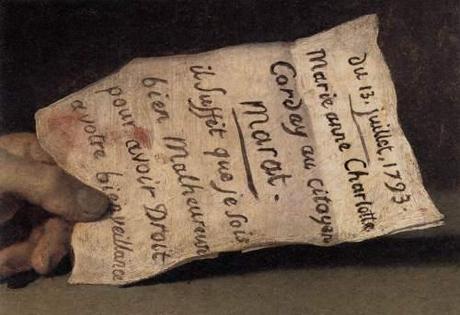
Charlotte hesitated then returned to her lodgings, where she sat at her small desk and wrote Marat a brief note: ‘Je viens de Caen, votre amour pour le patrie doit vous faire désirer connaître les complots qu’on y médite. J’attends votre réponse.’ (I have come from Caen, your love for the country must make you curious about the plots that are hatching there. I will wait for your reply.) She entrusted her note to a clerk and then requested that Citizeness Grollier, the owner of the hotel arrange for a hairdresser to come to her.
She spent the rest of the day at her lodgings, awaiting a reply from Marat which did not come. The hairdresser procured by Citizeness Grollier arrived and arranged her hair in a fashionable style with long ringlets that hung down to her slender waist before freshly powdering it. Charlotte then changed from her brown silk dress of earlier into a gown of fine spotted Indian muslin teamed with a clean fichu of pretty rose pink cotton. She tucked her birth certificate and a letter addressed to the French people into her chemise, where they would be discovered after her arrest.
After this, she sat again at her desk to write another, longer letter: ‘Je vous ai écrit ce matin, Marat, avez vous reçu ma lettre, puis-je espérer un moment d’audience ; si vous l’avez reçue j’espère que vous ne me refuserez pas, voyant combien la chose est intéressante. Suffit que je sois bien malheureuse pour avoir droit à votre protection.’ (I wrote to you this morning, Marat. Have you received my letter? I am hoping for a short audience. If you have received it, I hope that you will not refuse me for I have many interesting things to tell you. Let it be known that I am so unhappy as to have the right to your protection.)
Satisfied that her new letter was enough to pique Marat’s interest, she tucked her knife down the front of her dress, pulling her fine linen fichu closer to conceal it, picked up a green silk fan and once again ventured out into the sweltering Parisian streets, hailed another carriage and went back to the Rue des Cordeliers, arriving there at around seven in the evening. This time it was Simone who came down from the first floor apartment to apprehend the pretty visitor and demand to know why she was so keen to see Marat.
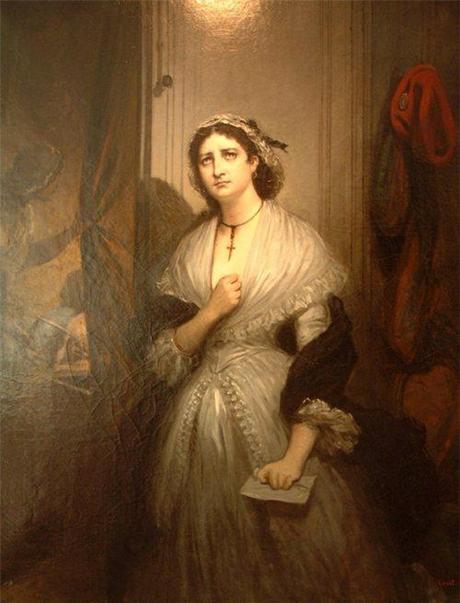
The two women had a bit of a row on the stairs, which would have ended in the formidable Simone ejecting Charlotte, until the latter decided to raise her voice and loudly protest that she only wanted to tell Marat about the plots and schemes being hatched by his Girondin enemies who had escaped Paris and taken refuge in Caen. As she had hoped, his interest was immediately stirred by what appeared to be a heaven sent opportunity to finally score some points against his enemies, the noted Girondins Madame Roland, Barbaroux, Brissot and Vergniaud and he called weakly from his bath that she should be allowed to come up to his room.
Marat greeted the very pretty Charlotte in the most friendly way, saying that he had read her notes and was keen to learn more before invited her to take a seat beside his bath to tell him more about the parlous situation in Normandy. Simone, still suspicious of the other young woman’s motives, also entered the room and sat with them as they talked about the Girondins, with Charlotte boldly providing a list of names of Girondins currently at large in Normandy, all of which Marat gleefully wrote down on the desk which went across his bath, chuckling all the time.
At this point, Simone, with a backward look of annoyance at Charlotte, left the room to fetch some more kaolin solution for the bathtub. Marat grinned at his guest and gestured to the list of names with his pen, saying: ‘Their heads will roll within a fortnight.’
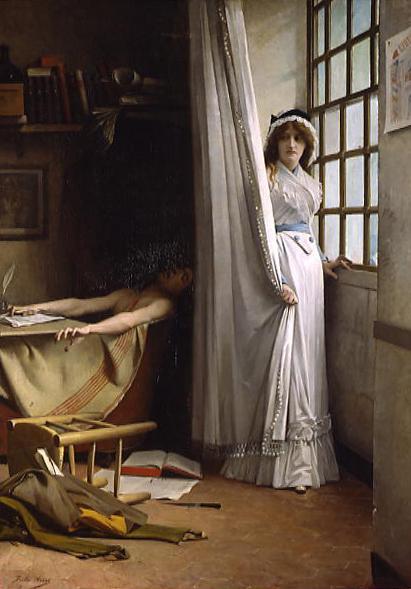
Charlotte did not return his grin, instead she rose to her feet, knocking her stool backwards as she stood up, pulled the knife out from the bosom of her dress and plunged it desperately into Marat’s exposed chest before pulling it out and dropping it on to the floor. She then took the list of names and hurled it into the water of his bath, hoping that this would be enough to destroy it and protect the identity of the people she had incriminated.
‘A moi, ma chère amie!’ the dying man howled, bringing Simone rushing back into the room, but it was too late as Marat died within seconds of being struck. She took one look at the wound which was pumping blood into the water and all over the makeshift desk and the papers on it and screeched: ‘My God, he has been murdered.’ Meanwhile, Charlotte made no real attempt to escape but instead backed away from the commotion that her actions had caused then walked calmly from the room.
‘Malheureuse, what have you done?’ Simone screamed at her as she went.
Alerted by Simone’s screams, Laurent Bas, one of Marat’s employees ran after Charlotte and immediately attempted to fell her by picking up a chair and hitting her with it. He then ignored her clear lack of resistance and insisted upon knocking her down then pinning her forcibly to the ground until the Commissaire de Police, Citizen Guellard arrived to arrest her.
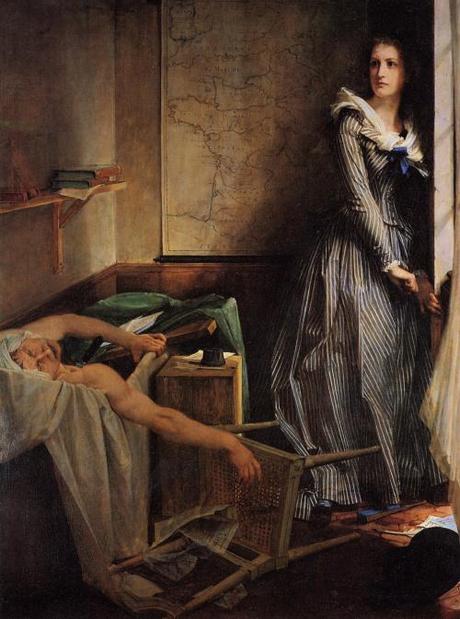
During the interrogation that followed, Charlotte made no attempt to deny that she had murdered Marat with her own hand and also insisted that she had acted alone.Throughout the course of her imprisonment and trial, the prosecutors sought in vain to insist that such a well bred young woman must surely have been acting on the behalf of a group of hardened plotters but she was to confound them all with her clear eyed insistence that there was no plot, no cell of malcontents and that the idea of murdering Marat had been her’s alone.
The news of Marat’s murder swept through the streets of the Cordeliers district, where he was a much loved figure and it didn’t take long for a large mob to assemble outside number 30 both to loudly mourn his premature passing and scream threats of retribution towards his assassin which floated up to the windows of the first floor flat as Charlotte, her face bruised and bloodied was interrogated and had her possessions confiscated.
Thanks to Laurent’s rough treatment, the birth certificate and letter that she had hidden beneath her chemise were revealed and one of her interrogators pulled them forcibly from her dress, tearing it in the process and almost revealing her breasts. Ashamed and horrified, Charlotte shook her hair forward to conceal them as best she could.
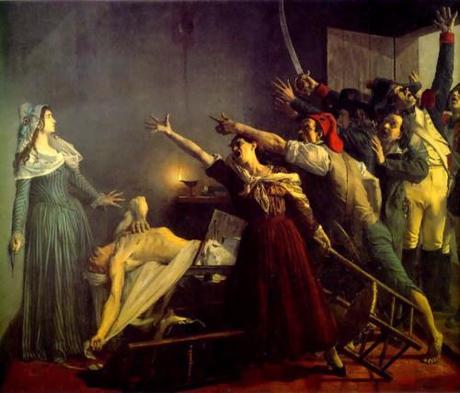
Finally, in the middle of the night an armed guard bundled Charlotte past a screaming, furious mob down the stairs and into a carriage. She was lucky to escape with her life as many of the crowd were determined to render their own retribution for her terrible act – however, it was pointed out to them that she was clearly part of some terrible terrorist cell based in the provinces and so must be kept alive long enough to name her co-conspirators.
Charlotte, bruised, exhausted but triumphant was taken through the dark streets to the prison of Abbaye, where she was led past staring, whispered gaolers and their fearsome dogs to a small, mean cell that had only recently been vacated by Madame Roland. Meanwhile, the city was in uproar as news of Marat’s assassination spread and it became known that a beautiful young woman from the provinces had been the one to deliver the fatal blow…
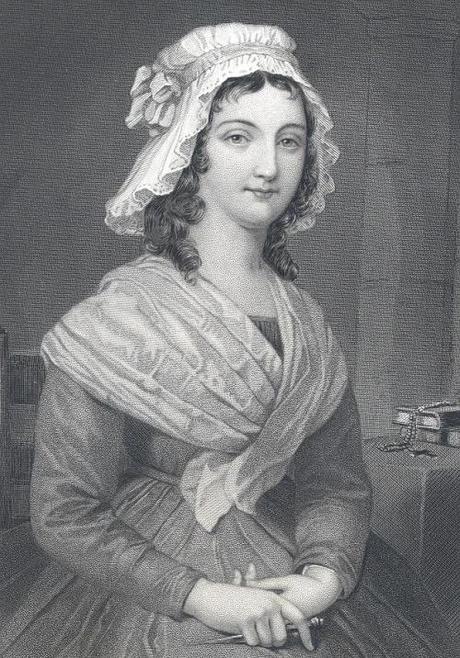
In the early hours of the morning of 14th July, after her arrest at 30 Rue des Cordeliers for the assassination of Marat, Charlotte Corday was taken a short distance to the Abbaye prison at the end of the Rue Sainte-Marguerite – a fearsome place with high gray walls topped by small turrets that overlooked the Boulevard Saint-Germain.
A screaming, jeering crowd followed the carriage that took Charlotte there, shaking their fists at her and making occasional attempts to grab hold of her that were swiftly deflected by the guardsmen who escorted the vehicle. Charlotte appeared to notice none of this as she sat, proudly erect and gazing serenely straight ahead, not even looking at the dark Paris streets as they rumbled slowly past.
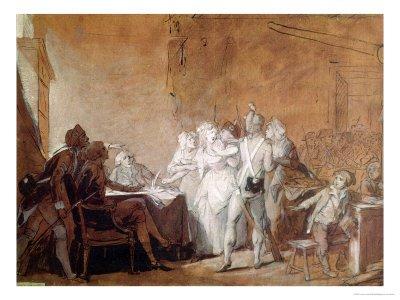
At the Abbaye, she was greeted by a crowd of surly gaolers and their ferocious dogs, who growled and snapped at her now sadly stained muslin skirts as she went by. Despite her protestations that she had acted alone and not as the tool of the disgraced Girondin party, the authorities were still determined to sniff out evidence of a conspiracy and so it was decreed that she must be imprisoned ‘en secrete‘, in absolute solitude both there and at the Conciergerie, where she was transferred just before her trial a few days later, cut off from prison life and allowed contact only with gaolers and the lawyer who had been appointed to defend her after the one that she had herself requested failed to turn up due to having been arrested himself thanks to his Girondin sympathies.
This probably suited Charlotte very well – she was a serious minded young woman who furthermore appears to have mentally already slipped out of reach to the other side of existence. The hectic, desperately pleasure seeking life in the Terror’s prisons would have held no allure for her.
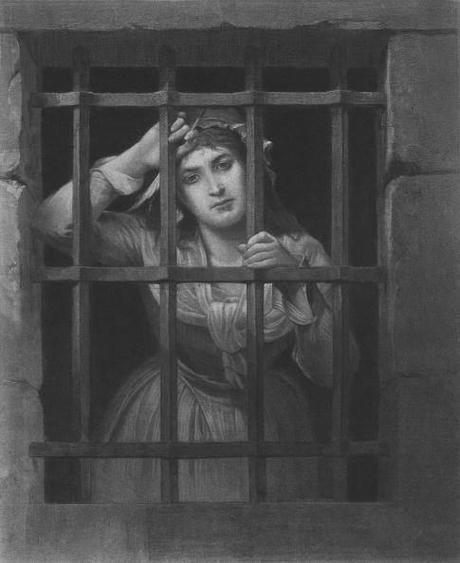
We don’t know precisely what Charlotte’s state of mind was as she paced the terracotta tiled floor of her damp, gloomy cell but it’s clear that not only had she embraced death but she was also thinking ahead to the judgment of posterity.
‘Ce 15 juillet 1793, an II de la République.
To the citizens of the Committee of General Safety.
Since I have only a few moments left to live, might I hope, citizens, that you will allow me to have my portrait painted. I would like to leave this token of my memory to my friends. Indeed, just as one cherishes the image of good citizens, curiosity sometimes seeks out those of great criminals, which serves to perpetuate horror at their crimes. If you deign to attend to my request, I would ask you to send me tomorrow a painter of miniatures. I would also repeat my request to be allowed to sleep alone. Believe, I beg you, in my sincere gratitude.
Marie Corday.‘
We can only imagine the reactions of Robespierre, Saint-Just and the other members of the Committee when this peculiar request was transmitted to them. However, their imagined bemusement aside, they complied and an artist, Hauër was sent to the Conciergerie during her trial to commence work on a portrait.
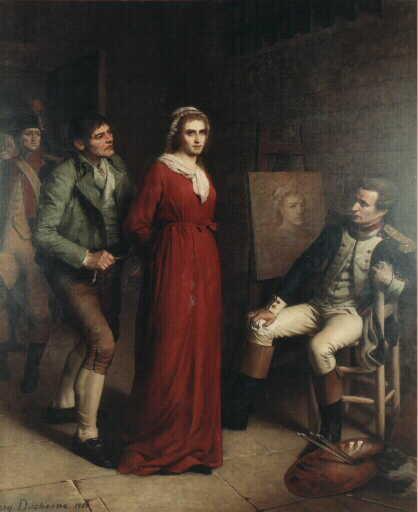
In the early hours of the morning of her trial, Charlotte requested more paper and sat down to write a letter to her father.
‘To M. Corday d’Armont, Rue de Bègle at Argentan.
Forgive me, my dear papa, for disposing of my life without your permission. I have avenged many innocent victims. I have prevented many another disaster. The people will one day be disabused and rejoice at being delivered from such a tyrant. I tried to persuade you to let me go to England where I hoped to remain incognito; but I realised how impossible that was. I hope you will not torment yourself on that account. In any case, I think you will have defenders at Caen. I have taken as my counsel Gustave Doulcet de Pontécoulant. Such a crime allows of no defence. It is for form’s sake.
Farewell, my dear papa, I beg you to forget me, or rather to rejoice at my fate, its cause is a fine one. I embrace my sister, whom I love with all my heart, and all my relations. Do not forget Corneille’s line: ‘Le crime fait la honte et non pas l’échaufaud.’
Judgement is to be passed on me tomorrow.’
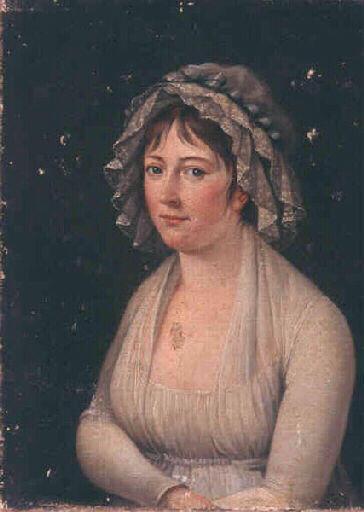
Charlotte was still unaware that her lawyer had been arrested and when she stepped into the dank crowded courtroom of the Palais de Justice, next to the Conciergerie and saw another lawyer, Chauveau-Lagarde waiting for her, she felt inspired to write another furious note later when the trial, such as it was, was over:
‘Citizen Doulcet Pontécoulant is a coward for refusing to defend me when it was such an easy matter. The lawyer who did so acquitted himself with all possible dignity and I shall remain grateful to him to the end.‘
As Charlotte had boldly and repeatedly admitted to her guilt and was also adamant that she had acted alone, there was very little for her lawyer to do but he did his best for her anyway, telling the tribunal that her ‘calm, such composure, such serenity in the face of death in a way sublime, are abnormal; they can only come from an exaltation of spirit born of political fanaticism. That is what put the knife in her hand.‘
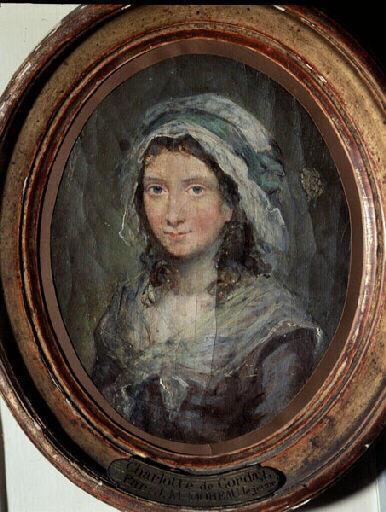
Corday herself said that: ‘Anything was justified for the security of the nation. I killed one man in order to save a thousand. I was a republican long before the Revolution and I have never lacked that resolution of people who can put aside personal interests and have no courage to sacrifice themselves for their country.‘
Even if the dread tribunal had wanted to save her, they were no match for her own avowed determination to sacrifice herself for the good of France and so it was no surprise to anyone when the terrifying, dark browed Fouquier-Tinville, stood up to deliver a guilty verdict, the gold ‘La Loi’ medallion at his breast swinging to and fro as he did so.
Charlotte bowed her head to the inevitable and slowly left the room, still ignoring the screams and shouts of the mob that had thronged the courtroom. She was taken back to her cell, where Hauër soon joined her to finish his portrait. Afterwards he commented on her ‘unimaginable tranquility and gaiety of spirit‘, while she in her turn commended his work as an excellent likeness.
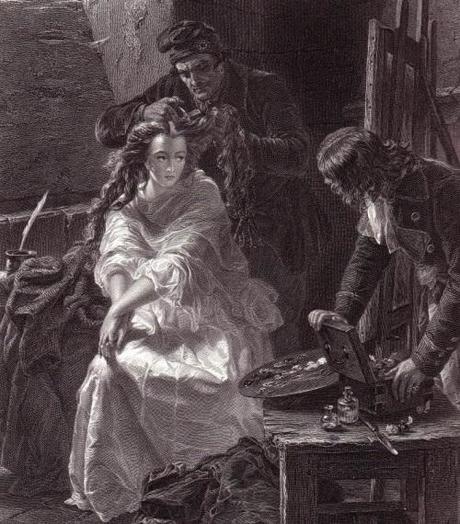
After this there was nothing to do but sit staring at the bare, damp speckled walls until the gendarmes arrived to take her away to the small, whitewashed, somewhat ironically named salle de la toilette on the ground floor where the executioner’s assistants awaited her with the scissors they would use to roughly cut her chestnut hair short and a long red dyed shift, which she was obliged to wear on her way to her execution in order to proclaim that she had been found guilty of parricide.
Charlotte sat down on the rickety stool in front of them and stared straight ahead, flinching only when the cold steel of their scissors touched her neck, which made the gendarmes laugh coarsely and make remarks about the ‘national razor’. She looked down at the ground, where her hair, which she had once been so proud of lay in thick, long strands around her shoes and then had to quickly look away before fear overcame her.
Once her hair had been cut, the men turned their backs as she removed her own dress and pulled the rough red shift over her head, allowing herself a rueful look down at how it hung so shapelessly around her body. After this one of the assistants stepped forward and tied her hands behind her back then led her outside.
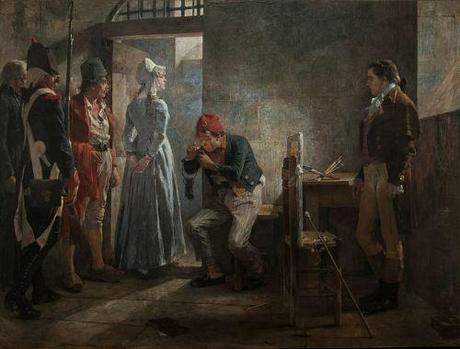
Like all other people who had been condemned by the Revolutionary Tribunal, she was taken out to the pale stone Cour de Mai, which actually seems quite beautiful in stark contrast to the medieval grimness of the Conciergerie. Here, an open wooden tumbril awaited them and without much ceremony she was bundled on to it. Charlotte, a girl from Normandy who had never been to Paris before, turned her head curiously to look at the beautiful Sainte Chapelle as the cart lurched forward and then slowly passed through the ornate iron gates.
The journey to the Place de de la Révolution took over an hour and she almost fell several times as the tumbril passed over the busy Pont au Change, turned on to the Quai de Mégisserie and then bounced alarmingly over the streets. Charlotte looked high above the heads of the curious, staring crowd that had lined the route to watch her pass and instead gazed about her at the city that she had never been to before and which she would never see again. The sky had been dark when she set off from the Conciergerie and now the threatened thunderstorm broke overhead, making many of the huge crowd that had gathered run for cover, their newspapers and aprons held over their heads as rain began to fall in a heavy downpour.
The tumbril rumbled down the long Rue Saint-Honoré past the gates of the Palais Royale where she had spent her last morning of freedom and which was as thronged and buzzing with life as ever. Charlotte, her teeth chattering in the freezing cold and her red chemise soaked through with rain, stared out across the colonnaded galleries and remembered how she had felt that day, full of nervous optimism, fear and excitement as she made her preparations for Marat’s assassination.
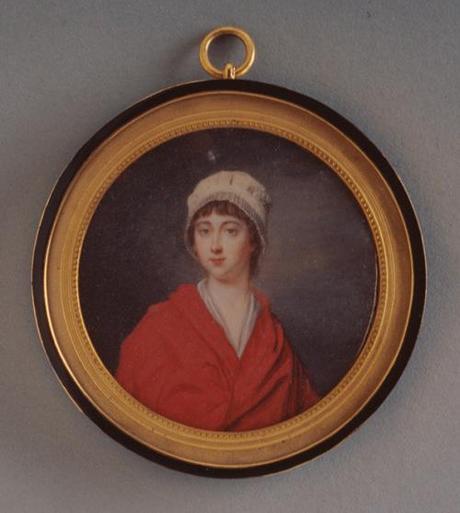
Unknown to her, Robespierre and his friends Desmoulins and Danton had gathered together at his window overlooking the execution route and were watching her as she went past. They were not the only ones to watch her in almost fearful admiration – more than one young man was struck by wholehearted infatuation for the brave, beautiful Charlotte as she stood alone in her cart, soaked through with rain, her lovely blue eyes already gazing mistily out into the next world.
They turned down the Rue Royale, at the end of which was the Place de la Révolution. Many of those condemned to death staggered and went pale as she caught their first glimpse of the guillotine, which rose, eerie and macabre in the distance but Charlotte gazed upon it impassively, even admiringly.
At around half past six in the evening, the tumbril came to a halt at the foot of the scaffold and gendarmes came forward to pull the young woman down to the ground. The executioner Sanson’s assistants then took her by the arms and led her to the scaffold steps. She ran lightly up the grimy, blood stained steps, turning at the top to look across to the Champs Elysées and then to the Tuileries. There was an invigorating, autumnal freshness in the air and she savoured every breath as they took hold of her again and led her to the guillotine.
Sanson, the executioner stepped in front of the machine, hoping to hide it from her eyes as she moved towards it. At this time, only a very few women had been guillotined and the men still behaved with careful courtesy, fearful of feminine panics and fainting fits, which would disorder the carefully constructed routine of execution, which was designed to be as smooth and fuss free as possible.
‘Please step aside, citizen,’ Charlotte said firmly. ‘I have never seen a guillotine before and am curious to know what it looks like.’
After the guillotine’s blade had ended Charlotte’s life, one of Sanson’s assistants, Legros who was not one of the permanent crew and had only been hired for the day, immediately snatched her head from inside the basket into which it had fallen and soundly slapped her cheeks. Sanson, who had done his best to treat Charlotte with courtesy and respect, was furious and immediately shouted at him to desist, while the crowd pressed closest to the scaffold recoiled in horror, many of them imagining that they had seen her cheeks blush with outrage.
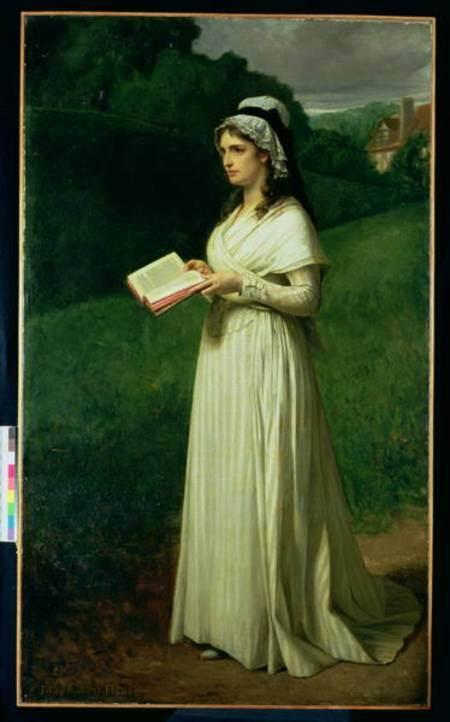
The Girondin, Vergniaud, one of those who had been condemned by Corday’s actions, afterwards said that ‘She has killed us, but she is showing us how to die.’
I originally posted this as a two parter three years ago and thought I’d join the two together to create a whole new piece on the two hundred and twenty first anniversary of Charlotte Corday’s execution – partially because I’ve always been rather proud of this piece but also because I’m a bit lazy. Okay, mostly the latter.
******
Set against the infamous Jack the Ripper murders of autumn 1888 and based on the author’s own family history, From Whitechapel is a dark and sumptuous tale of bittersweet love, friendship, loss and redemption and is available NOW from Amazon UK and Amazon US.
‘Frothy, light hearted, gorgeous. The perfect summer read.’ Minette, my young adult novel of 17th century posh doom and intrigue is now 99p from Amazon UK and 99c from Amazon US. CHEAP AS CHIPS as we like to say in dear old Blighty.
Blood Sisters, my novel of posh doom and iniquity during the French Revolution is just a fiver (offer is UK only sorry!) right now! Just use the clicky box on my blog sidebar to order your copy!
Follow me on Instagram.
